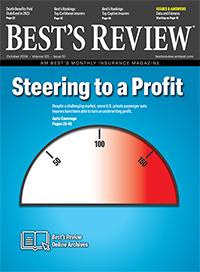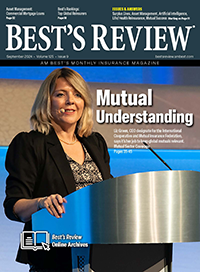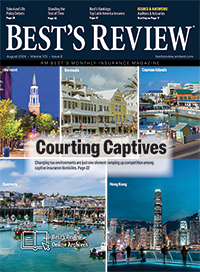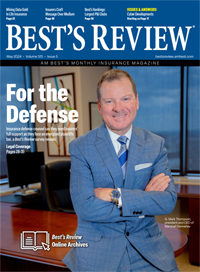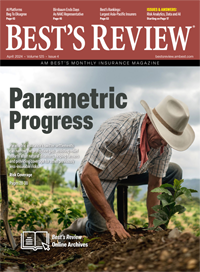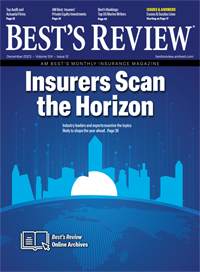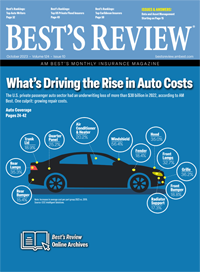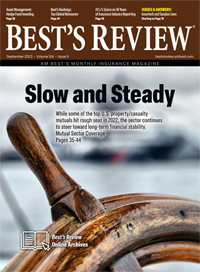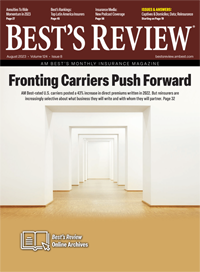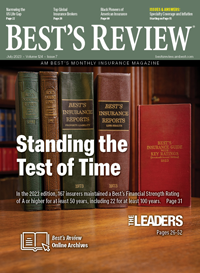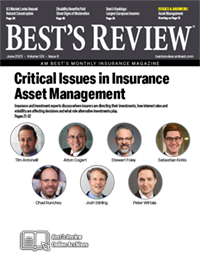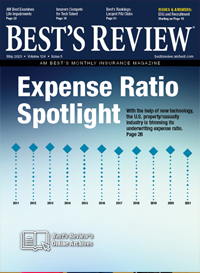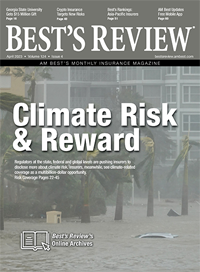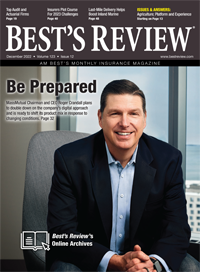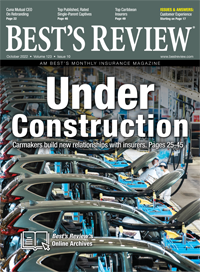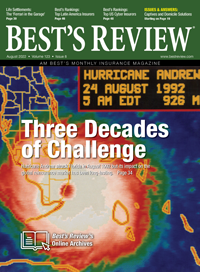Homeowners Insurance
A Burning Issue
The spread of wildfires in the United States raises new concerns about rates and the availability of homeowners insurance in parts of the nation.
- Lori Chordas
- November 2018
-





Key Points
- Sound the Alarm: Changing weather patterns and new construction in once remote areas are sparking a rise in wildfires in California.
- On Alert: That’s generating a rise in homeowners insurance rates and making availability of the coverage in fire-prone areas scarcer.
- Extinguishing the Blaze: Insurers are undertaking preventative measures, such as defense services, to help insureds faced by wildfires.
Two California wildfires consumed more than half a million acres this past summer, making 2018 the second consecutive year for devastating wildfires in the state and forcing insurers to reconsider their exposure and underwriting strategies.
Six of the top 20 most destructive California wildfires have occurred since the beginning of 2017, according to an A.M. Best report, citing figures from the California Department of Forestry and Fire Protection.
Insurers are still tallying up their losses from this year's fires, but losses from the Mendocino Complex and Carr fires so far have topped $845 million this year, according to the California Department of Insurance.
Rising populations, less frequent rainfall and climbing temperatures are contributing to the rise of wildfires across California and other parts of the nation, experts say.
California's natural environment and weather patterns are also increasing the likelihood of wildfires.
Since 1998, California hasn't had one year where average temperatures were below its normal average dating back to 1895, said Jason Hopper, an associate director at A.M. Best.
That's just one of the factors creating favorable conditions for wildfires, said Sridhar Manyem, director, A.M. Best.
“There have been conditions that have created the perfect storm in terms of an increase in vegetation because of recent rains, increase in fuel because there's been deadwood because of last year's fires, so that acted as a natural fuel,” Manyem said. “And the atmospheric conditions, the population growth, etc. All these conditions and the recent trend point to the fact that there is a possibility that this could be a trend in the future.”
The construction of new homes in once remote areas is also spurring the spread of wildfires.
California's foothill communities and the nation's wildland-urban interface, or the zone where natural areas and development meets, are expected to be especially hard-hit by those events.
“Imagine if you have a wildfire that starts out in the hills and it starts moving toward the more developed areas. These are the areas that are going to be most impacted and the first ones affected,” said Tammy Viggato, a senior scientist at AIR Worldwide.
Rapid development in areas prone to wildfires introduces combustible building materials and everyday activities that can start highly destructive blazes, said Kimberly Roberts, JLT Re Catastrophe Exposure and Risk Management Services vice president.
An unprecedented number of people are moving to the wildland-urban interface, where “burnable vegetation meets high-structure density,” Roberts said. “Many cities, particularly in the western U.S., have a ring of WUI around them.”
A Summer of Fires
One of the notable wildfires this past summer was the Mendocino Complex wildfire. It broke out in late July and destroyed or damaged nearly 300 homes and more than 459,000 acres of dry land in Northern California, making it the largest wildfire in California's recorded history.
The Carr Fire in Redding destroyed 1,080 homes and more than 229,650 acres in what is now considered the sixth most destructive wildfire ever in the state, according to the California Department of Forestry and Fire Protection.
The fire reportedly began from a spark caused by a flat tire. It has likely caused an estimated $1.5 billion in insured losses so far, with additional losses expected, according to the Best's Briefing, Wildfires: The New Normal?
So far this year in California, more than 876,400 acres of land have been charred by those calamities, a significant rise from the nearly 506,000 total acres that were burned in 2017, according to Cal Fire.
This year's fires followed a destructive 2017 wildfire season. The Tubbs Fire in 2017 ranked as the most destructive California wildfire, destroying some 5,636 structures. The Nuns, Thomas, Atlas and Redwood Valley fires also made the top 20 list.
The insured loss for fires in October and December last year were estimated at more than $12 billion by the state's insurance department.
“While it is still too early to conclusively determine the full impact of the wildfires, based on acreage and the number of fires to date, 2018 may produce greater losses for insurers compared to 2017,” according to the Best's Briefing.
Wildfires have become the new norm in the state, and that's taking a toll on both rates and availability of homeowners insurance coverage, said California Insurance Commissioner David Jones.
“Sadly, last year and this year's events are making wildfires the new normal for us,” Jones said. “Not only will the rise in wildfires pose challenges to insurance pricing and availability, but they'll also continue to raise public safety concerns,” he said.
The problem is not confined to just California.
Other parts of the nation are also being impacted by wildfires.
This year, the United States has already been struck by more than 46,700 wildfires, including two Utah fires in September and a fast-moving blaze in Eastpoint, Florida in June that destroyed dozens of homes.
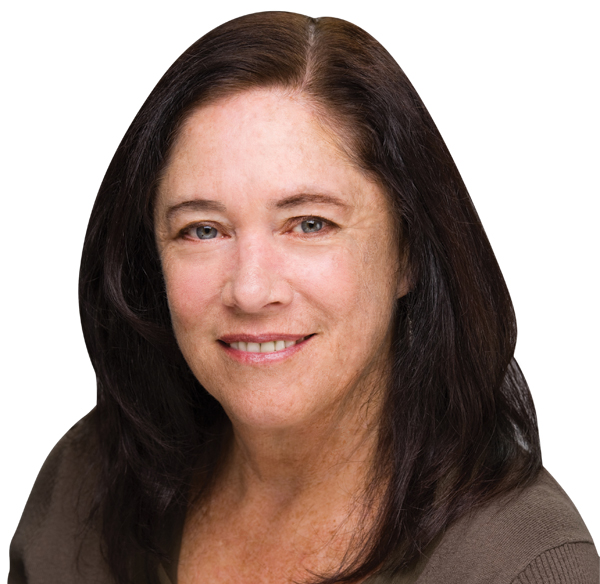
Janet Ruiz, Insurance Information Institute
The problem with wildfires isn’t just the destruction from fires themselves. It’s also the increase in building costs due to labor shortage and Canadian tariffs on wood.
What's Ahead for Insurers
The increased frequency and intensity of those disasters begs the question: What impact are wildfires having on homeowners insurance?
“Heading into the 2018 insurance year, insurers were well-capitalized. Therefore, we think that it is still going to be an earnings event. For some insurers, it could be a capital event. We'll know the more complete picture as things stabilize,” A.M. Best's Manyem said.
Insurers will need to reconsider their underwriting strategies and risk management to reflect shifting conditions in the current landscape, according to the Best's Briefing. Less sophisticated insurers who may have suffered losses will have to use more sophisticated analysis for decision-making with regard to underwriting and pricing, according to the report.
Pricing for perils such as smoke, ash, and brush fire may have to be re-evaluated, according to the report.
Rates, however, are probably headed higher, Jones said.
Californians pay, on average, $986 in annual homeowners insurance premiums, slightly less than the nationwide average of $1,173, according to reports.
By 2055, the cost for California properties with the highest fire risk could climb 18%, according to California's Fourth Climate Change Assessment. The regional report was led by the University of California, Davis.
Insurers in California, who must seek state approval to change rates, are limited to a maximum 6.9% rate increase. “Otherwise, they have to appeal for a higher percentage in a public hearing,” said A.M. Best senior financial analyst Ken Tappen.
California uses what Jones calls a catastrophic load factor for rate making. Insurers are required to spread recovery for cat losses over at least two decades and renew homeowners policies at least once following a catastrophic loss.
Rates aren't the only thing expected to rise.
Nonrenewal rates are climbing. Even before recent events, California was faced with a steady rise in nonrenewals. From 2015 to 2016, residents in 24 high-fire-danger counties saw a 15% spike in those rates, according to the state insurance department. This year's historic fires have even more insurers refusing to renew or write new policies in wildfire-prone areas, Jones said.
Even as the Carr and Mendocino fires flared this summer, some homeowners in San Francisco, Oakland and other parts of California received nonrenewal notices from their insurers.
Homeowners unable to find insurance in the traditional market have, over the years, turned to the surplus lines market or the state-sponsored California FAIR plan.
About 30,000 of California's 8 million single family insured dwellings in wildland areas are now insured by the plan, Jones said.
That number could soon grow, especially in high-fire areas such as the Sierra Nevada foothills and parts of San Bernardino County, according to a recent Rand Corp. report.
The FAIR plan was created as the state's insurer of last resort after the 1965 Watts riots in Los Angeles caused insurers to drop coverage in some urban areas. It provides insureds with $1.5 million in coverage for loss to a structure and its contents.
Regulation Changes
The growing spread of wildfires has led to new legislation and regulatory changes, including new home contents' coverage requirements.
“It's difficult for victims who were just burned out of their homes to prepare a detailed home inventory of the purchase dates, replacement values and other values for every possession in their home. That's asking a lot of people who are struggling to get back on their feet,” Jones said.
Earlier this year, the state commissioner urged insurers to consider paying out at least 75% of personal contents coverage without requiring a home inventory.
“A number of carriers have complied, and more than 90% of policies covered by insurers who insured homes destroyed by 2017 fires waived the requirement for a payout of at least 50%, with some going as high as 100%,” he said.
Jones also appealed to insurers in the state to set an expedited claims handling procedure following a wildfire event.
The procedure would require insurers to write a check to homeowners on the spot for up to four months following a loss, provide additional living expense coverage, offer at least a 30-day grace period for premiums and write an initial check for 25% of personal contents coverage with a home inventory.
California regulations also require a complete and comprehensive estimate of the cost to replace a home when a replacement estimate is provided by an insurer. However, state law doesn't mandate that insurers produce or regularly update a replacement cost calculation.
“The problem with wildfires isn't just the destruction from fires themselves. It's also the increase in building costs due to labor shortage and Canadian tariffs on wood,” said Janet Ruiz, the Insurance Information Institute's West Coast representative.
In August, California Governor Jerry Brown approved a bill, AB 1797, that now requires insurers to provide policyholders with a full replacement cost estimate every other year or apply an inflation factor to the dwelling limit at each renewal.
The governor in September signed a bill that addresses confusion surrounding extended replacement cost coverage. AB 1875 allows property owners to purchase limits above the estimated cost to replace their home.
It will also require insurers who don't provide at least 50% extended replacement cost coverage to help direct consumers to insurers that might.
Brown also signed a bill in September that was intended to strengthen consumer protections by requiring insurers to provide additional information to the Department of Insurance related to fire risk on residential property policies.
It also prohibits an insurer from canceling or not renewing residential property insurance policies for one year after the declaration of an emergency based solely on whether the property is located where wildfires have occurred.
Senate Bill 824 prohibits cancellations or non-renewals in some areas for one year and extends consumer protection to homeowners who survive wildfires along with those who experience total losses.
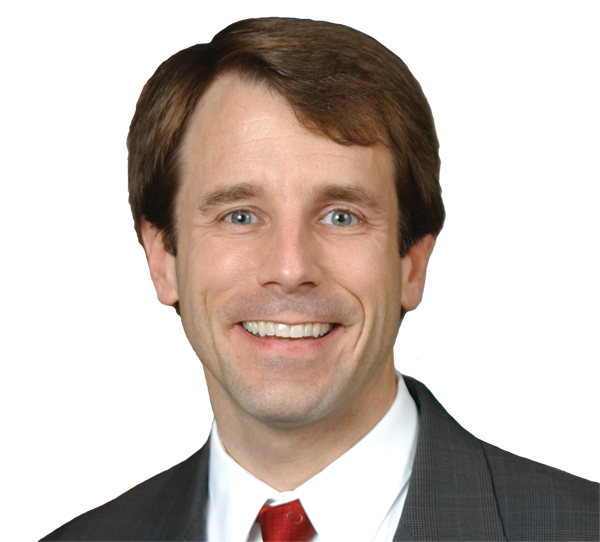
Dave Jones, California Department of Insurance
Sadly, last year and this year’s events are making wildfires the new normal for us. Not only will the rise in wildfires pose challenges to insurance pricing and availability, but they’ll also continue to raise public safety concerns.
Using Tools
The latest wildfires also have modelers updating and revising wildfire models.
RMS will be introducing a new probabilistic model that includes critical insights gathered from recent events, such as the 2017 Northern California fires, said Chris Folkman, senior director of product management at RMS.
The model will provide up-to-date information on building vulnerability and mitigation measures as well as quantify the potential contribution of ember and smoke damage to an insurer's overall wildfire loss, he said.
Often flying embers can cause a fire loss far beyond the burn perimeter, so they must be explicitly accounted for in any model, Folkman said.
During last year's Tubbs Fire high winds carried flaming embers, or burning chunks of fuel, across highways into neighborhoods in parts of Napa, Sonoma and Lake counties in Northern California, causing a devastating urban conflagration, he said.
“More recently, embers contributed to losses in the Carr Fire, which jumped the Sacramento River by means of the same wind-carried embers,” Folkman said.
Smoke can also trigger significant insurance losses.
“Evacuation orders can lead to business interruption and additional living expense claims, as well as structure and contents decontamination expenses. This was particularly evident in the 2017 Thomas Fire, which had a large smoke footprint in a high-exposure area,” Folkman said.
AIR Worldwide has recently updated its U.S. wildfire model.
In August, AIR released an updated model that provides a comprehensive view of the risk to property within the westernmost conterminous states.
The probabilistic model simulates how fires spread into areas based on wind speed and direction, availability of fuels, terrain and likelihood of suppression.
It also accounts for risk characteristics specific to wildfire-defensible space and communities participating in the National Fire Program Association's Firewise USA Program. The Firewise program teaches people how to adapt to living with wildfire and encourages neighbors to work together and take proactive action to prevent losses.
New data generated by models and other sources now has insurers re-evaluating how they assign fire risk scores to homes. Some California dwellings that were once deemed “safe” are now being rated as either “high” or “very high risk,” Jones said.
Last year, 4.5 million U.S. homes were identified as high or extreme risk of wildfire, with more than 2 million in California alone, according to Verisk's 2017 Wildfire Risk Analysis.
A Look Into the Future
California has certainly felt the heat of wildfires over the past two years.
By the end of the century, the average area destroyed by wildfires in California alone could climb as much as 77%, according to the state's Fourth Climate Change Assessment.
“It seems like every day we wake up and there's another wildfire occurring somewhere,” said Tyler Banks, national practice leader for Willis Towers Watson's personal lines division.
The increased length of the fire season is adding fuel to the fire. What was once a several-month concern has now become a year-round threat. “And that's placing a lot of strain on state and local resources,” Banks said.
“States are going to have to take a much more proactive look at where builders can build. They'll also have to decide whether they can develop close to urban wildlands,” he said.
Until recently, wildfires were largely considered an attritional risk, managed at the underwriting desk level with simple surcharges for properties in high-risk zones, RMS' Folkman said.
Recent disasters, however, have shown “that this alone is insufficient to maintain the profitability of an insurance portfolio,” he said.
“Insurers are now beginning to treat wildfire like the major perils of flood, hail, hurricane and earthquake, where the risk is comprehensively managed at multiple levels of the enterprise—at the underwriting desk through risk appetite guidelines, at the portfolio level with capital allocation strategies and with risk transfer through reinsurance purchasing,” Folkman said.
As insurers adjust to the new normal, communities are also taking steps to reduce their risk.
“Wildfire mitigation measures, such as creating defensible space around a home, can have an outsized influence on a property's loss propensity,” RMS's Folkman said. “The insurance industry will need to overcome data collection challenges to accommodate this, just like they did for hurricane and earthquake decades ago,” he said.
The Insurance Information Institute's Ruiz agreed.
“Together, we can develop more fire-resistant homes, work with programs like Firewise and the California Fire Safe Council and join in risk management and preventive efforts,” said Ruiz.
Insurers React
Insurers are taking steps of their own to limit property damage from the escalating threat of wildfires.
Insurers such as Chubb and PURE are contracting with third-party wildfire defense firms to receive monitoring and pre-suppression services if a fire approaches an at-risk property. AIG owns and operates its own wildfire defense trucks and crew.
Chubb offers Wildfire Defense Services as part of its Masterpiece Deluxe House Coverage for single-family homeowners clients in 18 states prone to wildfires.
Last year, Chubb's Wildfire Defense Services teams visited more than 1,000 properties exposed to active wildfires. Dozens of homes were saved as a result, said Ana Robic, chief operating officer of Chubb Personal Risk Services.
AIG Private Client Group's wildfire protection unit offers free loss mitigation services to policyholders in select areas. Wildfire protection specialists conduct at-home visits to assess the vulnerability of a property to wildfire. They also use mapping technology to identify insured homes in real-time as a wildfire approaches, remove combustibles and spray properties with a long-term fire-retardant.
Efforts like those are potentially lifesaving and can often generate homeowners' insurance premium discounts, said Tyler Banks, national practice leader for Willis Towers Watson's personal lines division.
Some insurers offer premium discounts for residents who live in Firewise communities and offer grants to those communities, said Janet Ruiz, the Insurance Information Institute's West Coast representative.
The National Fire Program Association's Firewise USA program teaches people how to adapt to living with wildfire and encourages neighbors to work together and take proactive action to prevent losses.
“It's important for homeowners to involve carriers early in the process. Also, they should follow carriers' recommendations, such as using nonflammable roof materials and closing vents inside the home,” Banks said.
That's where education and training programs can help.
The Rocky Mountain Insurance Association and the NFPA offer Firewise virtual workshops to connect wildland fire stakeholders with subject matter experts. The Insurance Institute for Business and Home Safety educates consumers about the dangers of wind-blown embers.
Mercury Insurance has taken a number of steps to address the rise in wildfires.
Last year, the Los Angeles-based insurer purchased additional reinsurance to protect against cat events. It also introduced a new FireLine wildfire risk underwriting and rating plan.
“We feel FireLine is a better overall wildfire risk evaluation model than just looking at pure distance. So far, it's been working very well for us,” said Jane Li, product manager at Mercury.
The company requires insureds living in wildfire-risk zones to take precautionary steps, such as trimming tree branches too close to a roof and maintaining state-required defensible space around the home.
“Mercury is always there to help our insureds—both pre- and post-event,” Li said.
“We encourage our agents to reach out to customers at least once a year to make sure they have adequate coverage in the event of a catastrophe. We provide tips and materials to help them prepare for these events, and we immediately deploy mobile claims teams to ensure that our customers get the help and support they need as quickly as possible when disaster strikes,” she said.
Learn More
American International Group Inc. (A.M. Best # 058702)
The Chubb Corp. (A.M. Best # 058342)
For ratings and other financial strength information visit www.ambest.com
Lori Chordas is a senior associate editor. She can be reached at lori.chordas@ambest.com.



